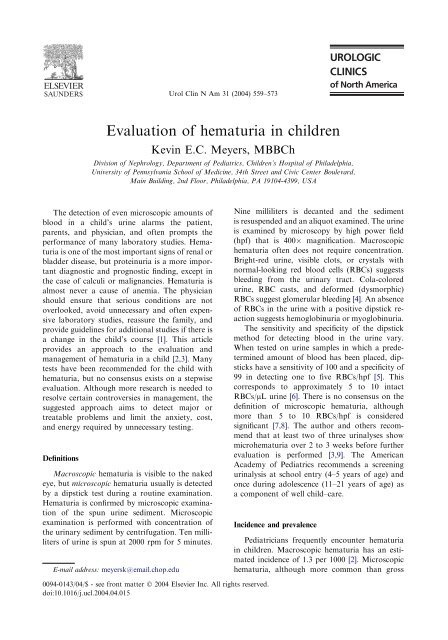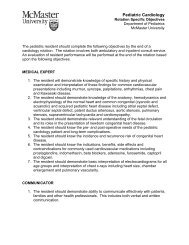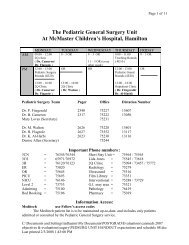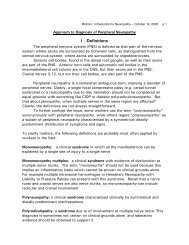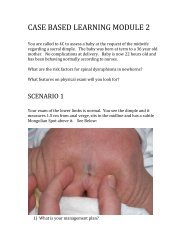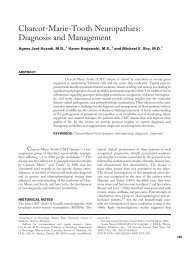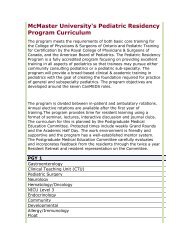Evaluation of hematuria in children - Nephrology
Evaluation of hematuria in children - Nephrology
Evaluation of hematuria in children - Nephrology
You also want an ePaper? Increase the reach of your titles
YUMPU automatically turns print PDFs into web optimized ePapers that Google loves.
Urol Cl<strong>in</strong> N Am 31 (2004) 559–573<br />
<strong>Evaluation</strong> <strong>of</strong> <strong>hematuria</strong> <strong>in</strong> <strong>children</strong><br />
Kev<strong>in</strong> E.C. Meyers, MBBCh<br />
Division <strong>of</strong> <strong>Nephrology</strong>, Department <strong>of</strong> Pediatrics, Children’s Hospital <strong>of</strong> Philadelphia,<br />
University <strong>of</strong> Pennsylvania School <strong>of</strong> Medic<strong>in</strong>e, 34th Street and Civic Center Boulevard,<br />
Ma<strong>in</strong> Build<strong>in</strong>g, 2nd Floor, Philadelphia, PA 19104-4399, USA<br />
The detection <strong>of</strong> even microscopic amounts <strong>of</strong><br />
blood <strong>in</strong> a child’s ur<strong>in</strong>e alarms the patient,<br />
parents, and physician, and <strong>of</strong>ten prompts the<br />
performance <strong>of</strong> many laboratory studies. Hematuria<br />
is one <strong>of</strong> the most important signs <strong>of</strong> renal or<br />
bladder disease, but prote<strong>in</strong>uria is a more important<br />
diagnostic and prognostic f<strong>in</strong>d<strong>in</strong>g, except <strong>in</strong><br />
the case <strong>of</strong> calculi or malignancies. Hematuria is<br />
almost never a cause <strong>of</strong> anemia. The physician<br />
should ensure that serious conditions are not<br />
overlooked, avoid unnecessary and <strong>of</strong>ten expensive<br />
laboratory studies, reassure the family, and<br />
provide guidel<strong>in</strong>es for additional studies if there is<br />
a change <strong>in</strong> the child’s course [1]. This article<br />
provides an approach to the evaluation and<br />
management <strong>of</strong> <strong>hematuria</strong> <strong>in</strong> a child [2,3]. Many<br />
tests have been recommended for the child with<br />
<strong>hematuria</strong>, but no consensus exists on a stepwise<br />
evaluation. Although more research is needed to<br />
resolve certa<strong>in</strong> controversies <strong>in</strong> management, the<br />
suggested approach aims to detect major or<br />
treatable problems and limit the anxiety, cost,<br />
and energy required by unnecessary test<strong>in</strong>g.<br />
Def<strong>in</strong>itions<br />
Macroscopic <strong>hematuria</strong> is visible to the naked<br />
eye, but microscopic <strong>hematuria</strong> usually is detected<br />
by a dipstick test dur<strong>in</strong>g a rout<strong>in</strong>e exam<strong>in</strong>ation.<br />
Hematuria is confirmed by microscopic exam<strong>in</strong>ation<br />
<strong>of</strong> the spun ur<strong>in</strong>e sediment. Microscopic<br />
exam<strong>in</strong>ation is performed with concentration <strong>of</strong><br />
the ur<strong>in</strong>ary sediment by centrifugation. Ten milliliters<br />
<strong>of</strong> ur<strong>in</strong>e is spun at 2000 rpm for 5 m<strong>in</strong>utes.<br />
E-mail address: meyersk@email.chop.edu<br />
N<strong>in</strong>e milliliters is decanted and the sediment<br />
is resuspended and an aliquot exam<strong>in</strong>ed. The ur<strong>in</strong>e<br />
is exam<strong>in</strong>ed by microscopy by high power field<br />
(hpf) that is 400 magnification. Macroscopic<br />
<strong>hematuria</strong> <strong>of</strong>ten does not require concentration.<br />
Bright-red ur<strong>in</strong>e, visible clots, or crystals with<br />
normal-look<strong>in</strong>g red blood cells (RBCs) suggests<br />
bleed<strong>in</strong>g from the ur<strong>in</strong>ary tract. Cola-colored<br />
ur<strong>in</strong>e, RBC casts, and deformed (dysmorphic)<br />
RBCs suggest glomerular bleed<strong>in</strong>g [4]. An absence<br />
<strong>of</strong> RBCs <strong>in</strong> the ur<strong>in</strong>e with a positive dipstick reaction<br />
suggests hemoglob<strong>in</strong>uria or myoglob<strong>in</strong>uria.<br />
The sensitivity and specificity <strong>of</strong> the dipstick<br />
method for detect<strong>in</strong>g blood <strong>in</strong> the ur<strong>in</strong>e vary.<br />
When tested on ur<strong>in</strong>e samples <strong>in</strong> which a predeterm<strong>in</strong>ed<br />
amount <strong>of</strong> blood has been placed, dipsticks<br />
have a sensitivity <strong>of</strong> 100 and a specificity <strong>of</strong><br />
99 <strong>in</strong> detect<strong>in</strong>g one to five RBCs/hpf [5]. This<br />
corresponds to approximately 5 to 10 <strong>in</strong>tact<br />
RBCs/lL ur<strong>in</strong>e [6]. There is no consensus on the<br />
def<strong>in</strong>ition <strong>of</strong> microscopic <strong>hematuria</strong>, although<br />
more than 5 to 10 RBCs/hpf is considered<br />
significant [7,8]. The author and others recommend<br />
that at least two <strong>of</strong> three ur<strong>in</strong>alyses show<br />
micro<strong>hematuria</strong> over 2 to 3 weeks before further<br />
evaluation is performed [3,9]. The American<br />
Academy <strong>of</strong> Pediatrics recommends a screen<strong>in</strong>g<br />
ur<strong>in</strong>alysis at school entry (4–5 years <strong>of</strong> age) and<br />
once dur<strong>in</strong>g adolescence (11–21 years <strong>of</strong> age) as<br />
a component <strong>of</strong> well child–care.<br />
Incidence and prevalence<br />
Pediatricians frequently encounter <strong>hematuria</strong><br />
<strong>in</strong> <strong>children</strong>. Macroscopic <strong>hematuria</strong> has an estimated<br />
<strong>in</strong>cidence <strong>of</strong> 1.3 per 1000 [2]. Microscopic<br />
<strong>hematuria</strong>, although more common than gross<br />
0094-0143/04/$ - see front matter Ó 2004 Elsevier Inc. All rights reserved.<br />
doi:10.1016/j.ucl.2004.04.015
560 K.E.C. Meyers / Urol Cl<strong>in</strong> N Am 31 (2004) 559–573<br />
<strong>hematuria</strong>, has a variably reported <strong>in</strong>cidence<br />
depend<strong>in</strong>g on the def<strong>in</strong>ition used for mak<strong>in</strong>g the<br />
diagnosis. The <strong>in</strong>cidence <strong>of</strong> microscopic <strong>hematuria</strong><br />
<strong>in</strong> school<strong>children</strong> was estimated at 0.41%<br />
when four ur<strong>in</strong>e samples per child were collected<br />
and 0.32% <strong>in</strong> girls and 0.14% <strong>in</strong> boys when five<br />
consecutive ur<strong>in</strong>e specimens were analyzed over 5<br />
years [10,11]. Microscopic <strong>hematuria</strong> <strong>in</strong> two or<br />
more ur<strong>in</strong>e samples is found <strong>in</strong> 1% to 2% <strong>of</strong><br />
<strong>children</strong> 6 to 15 years <strong>of</strong> age.<br />
Pathophysiology<br />
Hematuria may orig<strong>in</strong>ate from the glomeruli,<br />
renal tubules and <strong>in</strong>terstitium, or ur<strong>in</strong>ary tract<br />
(<strong>in</strong>clud<strong>in</strong>g collect<strong>in</strong>g systems, ureters, bladder, and<br />
urethra) (Boxes 1 and 2). In <strong>children</strong>, the source <strong>of</strong><br />
bleed<strong>in</strong>g is more <strong>of</strong>ten from glomeruli than from<br />
the ur<strong>in</strong>ary tract. RBCs cross the glomerular<br />
endothelial-epithelial barrier and enter the capillary<br />
lumen through structural discont<strong>in</strong>uities <strong>in</strong> the<br />
capillary wall. These discont<strong>in</strong>uities seem to be at<br />
the capillary wall–mesangial cell reflections [12].In<br />
most cases, prote<strong>in</strong>uria, RBC casts, and deformed<br />
(dysmorphic) RBCs <strong>in</strong> the ur<strong>in</strong>e accompany <strong>hematuria</strong><br />
caused by any <strong>of</strong> the glomerulonephritides.<br />
The renal papillae are susceptible to necrotic<br />
<strong>in</strong>jury from microthrombi and anoxia <strong>in</strong> patients<br />
with a hemoglob<strong>in</strong>opathy or <strong>in</strong> those exposed to<br />
tox<strong>in</strong>s. Patients with renal parenchymal lesions<br />
may have episodes <strong>of</strong> transient microscopic or<br />
macroscopic <strong>hematuria</strong> dur<strong>in</strong>g systemic <strong>in</strong>fections<br />
or after moderate exercise. This may be the result<br />
<strong>of</strong> renal hemodynamic responses to exercise or<br />
fever by undeterm<strong>in</strong>ed mechanisms.<br />
Initial evaluation<br />
Macroscopic <strong>hematuria</strong><br />
The evaluation <strong>of</strong> a child with gross <strong>hematuria</strong><br />
differs from that <strong>of</strong> microscopic <strong>hematuria</strong> (Fig. 1).<br />
Macroscopic <strong>hematuria</strong> <strong>of</strong> glomerular orig<strong>in</strong> usually<br />
is described as brown, tea-colored, or colacolored,<br />
whereas macroscopic <strong>hematuria</strong> from the<br />
lower ur<strong>in</strong>ary tract (bladder and urethra) is usually<br />
p<strong>in</strong>k or red. Macroscopic <strong>hematuria</strong> <strong>in</strong> the absence<br />
<strong>of</strong> significant prote<strong>in</strong>uria or RBC casts is an<br />
<strong>in</strong>dication for a renal and bladder ultrasound to<br />
exclude malignancy or cystic renal disease. Referral<br />
to a urologist is required when cl<strong>in</strong>ical<br />
evaluation and workup <strong>in</strong>dicates that there is<br />
a tumor, a structural urogenital abnormality, or<br />
an obstruct<strong>in</strong>g calculus. A urologist also should<br />
Box 1. Causes <strong>of</strong> <strong>hematuria</strong> <strong>in</strong> <strong>children</strong><br />
Glomerular diseases<br />
Recurrent gross <strong>hematuria</strong> (IgA<br />
nephropathy, benign familial<br />
<strong>hematuria</strong>, Alport’s syndrome)<br />
Acute poststreptococcal<br />
glomerulonephritis<br />
Membranoproliferative<br />
glomerulonephritis<br />
Systemic lupus erythematosus<br />
Membranous nephropathy<br />
Rapidly progressive<br />
glomerulonephritis<br />
Henoch-Schonle<strong>in</strong> purpura<br />
Goodpasture’s disease<br />
Interstitial and tubular<br />
Acute pyelonephritis<br />
Acute <strong>in</strong>terstitial nephritis<br />
Tuberculosis<br />
Hematologic (sickle cell disease,<br />
coagulopathies von Willebrand’s<br />
disease, renal ve<strong>in</strong> thrombosis,<br />
thrombocytopenia)<br />
Ur<strong>in</strong>ary tract<br />
Bacterial or viral (adenovirus)<br />
<strong>in</strong>fection–related<br />
Nephrolithiasis and hypercalciuria<br />
Structural anomalies, congenital<br />
anomalies, polycystic kidney<br />
disease<br />
Trauma<br />
Tumors<br />
Exercise<br />
Medications (am<strong>in</strong>oglycosides,<br />
amitryptil<strong>in</strong>e, anticonvulsants,<br />
aspir<strong>in</strong>, chlorpromaz<strong>in</strong>e, coumad<strong>in</strong>,<br />
cyclophosphamide, diuretics,<br />
penicill<strong>in</strong>, thoraz<strong>in</strong>e)<br />
evaluate <strong>children</strong> with recurrent nonglomerular<br />
macroscopic <strong>hematuria</strong> <strong>of</strong> undeterm<strong>in</strong>ed orig<strong>in</strong><br />
because cystoscopy may be warranted.<br />
Microscopic <strong>hematuria</strong><br />
Microscopic <strong>hematuria</strong>, def<strong>in</strong>ed by more than<br />
five RBCs/hpf, almost always warrants referral to<br />
a nephrologist rather than an urologist. Figs. 2<br />
and 3 give an approach to the evaluation <strong>of</strong><br />
asymptomatic and symptomatic microscopic
K.E.C. Meyers / Urol Cl<strong>in</strong> N Am 31 (2004) 559–573<br />
561<br />
Box 2. Causes <strong>of</strong> asymptomatic isolated<br />
microscopic <strong>hematuria</strong><br />
Common<br />
Undeterm<strong>in</strong>ed<br />
Benign familial<br />
Idiopathic hypercalciuria<br />
IgA nephropathy<br />
Sickle cell trait or anemia<br />
Transplant<br />
Less common<br />
Alport nephritis<br />
Post<strong>in</strong>fectious glomerulonephritis<br />
Trauma<br />
Exercise<br />
Nephrolithiasis<br />
Henoch-Schonle<strong>in</strong> purpura<br />
Uncommon<br />
Drugs and tox<strong>in</strong>s<br />
Coagulopathy<br />
Ureteropelvic junction obstruction<br />
Focal segmental glomerulosclerosis<br />
Membranous glomerulonephritis<br />
Membranoproliferative<br />
glomerulonephritis<br />
Lupus nephritis<br />
Hydronephrosis<br />
Pyelonephritis<br />
Vascular malformation<br />
Tuberculosis<br />
Tumor<br />
(Adapted from Lieu TA, Grasmeder M,<br />
Kaplan BS. An approach to the evaluation<br />
and treatment <strong>of</strong> microscopic <strong>hematuria</strong>.<br />
Pediatr Cl<strong>in</strong> North Am 1991;38:579–92.)<br />
<strong>hematuria</strong>. Most <strong>children</strong> with isolated microscopic<br />
<strong>hematuria</strong> do not have a treatable or serious<br />
cause for <strong>hematuria</strong> and do not require an<br />
extensive evaluation. The presence <strong>of</strong> <strong>hematuria</strong><br />
must be confirmed by microscopy exam<strong>in</strong>ation <strong>of</strong><br />
spun sediment <strong>of</strong> ur<strong>in</strong>e because other substances<br />
besides blood can produce red or brown ur<strong>in</strong>e or<br />
give a false positive dipstick test for blood (Box 3).<br />
Once a positive dipstick result has been confirmed<br />
by microscopic exam<strong>in</strong>ation <strong>of</strong> spun sediment<br />
<strong>of</strong> ur<strong>in</strong>e, it is advisable to redirect attention<br />
to more specific aspects <strong>of</strong> the history and physical<br />
exam<strong>in</strong>ation (Box 4).<br />
History<br />
A history <strong>of</strong> dysuria, frequency, urgency, or<br />
flank or abdom<strong>in</strong>al pa<strong>in</strong> suggests a diagnosis <strong>of</strong><br />
ur<strong>in</strong>ary tract <strong>in</strong>fection or nephrolithiasis. Recent<br />
trauma, strenuous exercise, menstruation, or bladder<br />
catheterization may account for transient<br />
<strong>hematuria</strong>. A sore throat or sk<strong>in</strong> <strong>in</strong>fection with<strong>in</strong><br />
the past 2 to 4 weeks directs the evaluation toward<br />
post<strong>in</strong>fectious glomerulonephritis. Drugs and<br />
tox<strong>in</strong>s may cause either <strong>hematuria</strong> or hemoglob<strong>in</strong>uria<br />
(Box 5). A careful family history must <strong>in</strong>clude<br />
questions about <strong>hematuria</strong>, hear<strong>in</strong>g loss, hypertension,<br />
nephrolithiasis, renal diseases, renal cystic<br />
diseases, hemophilia, sickle cell trait, and dialysis<br />
or transplant.<br />
Physical exam<strong>in</strong>ation<br />
The presence or absence <strong>of</strong> hypertension or<br />
prote<strong>in</strong>uria helps to decide how extensively to<br />
pursue the diagnostic evaluation. If the blood<br />
pressure is normal and the patient is pass<strong>in</strong>g<br />
normal amounts <strong>of</strong> ur<strong>in</strong>e, it is unlikely that<br />
microscopic <strong>hematuria</strong>, whatever its cause, warrants<br />
immediate treatment. If the blood pressure is<br />
elevated, the <strong>hematuria</strong> requires a more <strong>in</strong>tensive<br />
diagnostic evaluation. The presence <strong>of</strong> fever or<br />
costovertebral angle tenderness may <strong>in</strong>dicate a<br />
ur<strong>in</strong>ary tract <strong>in</strong>fection. An abdom<strong>in</strong>al mass may<br />
be caused by a tumor, hydronephrosis, multicystic<br />
dysplastic kidney, or polycystic kidney disease.<br />
Macroscopic <strong>hematuria</strong> with prote<strong>in</strong>uria suggests<br />
glomerulonephritis. Rashes and arthritis can occur<br />
<strong>in</strong> Henoch-Schonle<strong>in</strong> purpura and systemic lupus<br />
erythematosus. Edema is an important feature <strong>of</strong><br />
the nephrotic syndrome (Table 1).<br />
Laboratory studies<br />
Only two diagnostic tests are required for<br />
a child with microscopic <strong>hematuria</strong>: (1) a test for<br />
prote<strong>in</strong>uria and (2) a microscopic exam<strong>in</strong>ation <strong>of</strong><br />
the ur<strong>in</strong>e for RBCs and RBC casts. Children with<br />
macroscopic <strong>hematuria</strong> require ur<strong>in</strong>e culture and<br />
renal imag<strong>in</strong>g by ultrasound. Prote<strong>in</strong>uria may be<br />
present regardless <strong>of</strong> the cause <strong>of</strong> bleed<strong>in</strong>g, but<br />
usually does not exceed 2þ (100 mg/dL) if the only<br />
source <strong>of</strong> prote<strong>in</strong> is from the blood. This is<br />
especially true if the child has microscope <strong>hematuria</strong>.<br />
Patients with 1þ to 2þ prote<strong>in</strong>uria should be<br />
evaluated for orthostatic (postural) prote<strong>in</strong>uria. A<br />
patient with more than 2þ prote<strong>in</strong>uria should be<br />
<strong>in</strong>vestigated for glomerulonephritis and nephrotic<br />
syndrome. RBC casts, when present, are a highly<br />
specific marker for glomerulonephritis, but their
562 K.E.C. Meyers / Urol Cl<strong>in</strong> N Am 31 (2004) 559–573<br />
Macroscopic <strong>hematuria</strong><br />
Symptoms and signs <strong>of</strong> a glomerulonephritis -<br />
edema/hypertension/prote<strong>in</strong>uria/RBC casts<br />
No<br />
Yes<br />
Check basic metabolic<br />
panel,complete blood count,<br />
complement C3, album<strong>in</strong>,<br />
anti-streptolys<strong>in</strong> titer, and<br />
streptozyme<br />
CT scan <strong>of</strong> abdomen/pelvis<br />
Ur<strong>in</strong>e culture<br />
Renal ultrasound<br />
Yes<br />
Yes<br />
History <strong>of</strong> trauma<br />
No<br />
Signs/Symptoms <strong>of</strong> UTI<br />
No<br />
Refer to a Pediatric<br />
Nephrologist<br />
Tests consistent with<br />
post <strong>in</strong>fectious<br />
glomerulonephritis<br />
No<br />
Yes<br />
Supportive<br />
therapy<br />
Renal ultrasound<br />
24 hr ur<strong>in</strong>e collection<br />
for metabolic stone pr<strong>of</strong>ile<br />
Yes<br />
Family history <strong>of</strong> stones<br />
No<br />
Hypertension<br />
Hyperkalemia<br />
Azotemia<br />
Obstruct<strong>in</strong>g stone<br />
Refer to a Urologist<br />
Renal ultrasound, Ur<strong>in</strong>e culture, Test parents for<br />
<strong>hematuria</strong>, Hemaglob<strong>in</strong> electophoresis, Ur<strong>in</strong>e<br />
calcium/creat<strong>in</strong>e ratio<br />
Tumor, structural abnormality<br />
Fig. 1. <strong>Evaluation</strong> <strong>of</strong> a child with macroscopic <strong>hematuria</strong>.<br />
absence does not rule out glomerular disease and<br />
their presence does not prove that glomerular<br />
<strong>in</strong>jury has occurred. RBC casts should be searched<br />
for diligently, however. Distorted, misshapen<br />
erythrocytes (dysmorphic) also suggest a glomerular<br />
orig<strong>in</strong> for bleed<strong>in</strong>g.<br />
Indications for prompt evaluation<br />
The <strong>in</strong>itial evaluation should be directed toward<br />
important and potentially life-threaten<strong>in</strong>g<br />
causes <strong>of</strong> <strong>hematuria</strong> <strong>in</strong> any child who has any <strong>of</strong><br />
the follow<strong>in</strong>g <strong>in</strong> addition to <strong>hematuria</strong>: hypertension,<br />
edema oliguria, significant prote<strong>in</strong>uria (more<br />
than 500 mg per 24 hours), or RBC casts. These<br />
causes <strong>in</strong>clude acute post<strong>in</strong>fectious glomerulonephritis<br />
(PIGN), Henoch-Schonlien purpura<br />
(HSP), hemolytic-uremic syndrome, membranoproliferative<br />
glomerulonephritis, IgA nephropathy,<br />
and focal segmental glomerulosclerosis.<br />
This <strong>in</strong>itial evaluation should <strong>in</strong>clude a complete<br />
blood count (hemolytic-uremic syndrome),<br />
throat culture, streptozyme panel and serum C3<br />
concentration (acute poststreptococcal glomerulonephritis),<br />
and serum creat<strong>in</strong><strong>in</strong>e and potassium<br />
concentrations (if there is renal <strong>in</strong>sufficiency). All<br />
<strong>children</strong> with macroscopic <strong>hematuria</strong> require renal<br />
ultrasound upon presentation. Pend<strong>in</strong>g the<br />
results <strong>of</strong> these tests, the child’s blood pressure<br />
and ur<strong>in</strong>e output must be monitored frequently.<br />
If the cause <strong>of</strong> the <strong>hematuria</strong> rema<strong>in</strong>s unclear<br />
after the results <strong>of</strong> the above tests have been<br />
obta<strong>in</strong>ed, a 24-hour ur<strong>in</strong>e collection for prote<strong>in</strong>,<br />
creat<strong>in</strong><strong>in</strong>e, and calcium should be obta<strong>in</strong>ed. Children<br />
with micro<strong>hematuria</strong> and prote<strong>in</strong> excretion <strong>of</strong><br />
less than 25 mg/dL (6 mg/h/m 2 ) usually do not have<br />
a glomerulopathy and can be considered to have<br />
isolated microscopic <strong>hematuria</strong>. Some, however,<br />
may have IgA nephropathy, early or mild Alport’s<br />
syndrome, or th<strong>in</strong> basement membrane disease.<br />
There is no specific treatment, however, for any <strong>of</strong><br />
these conditions. The causes <strong>of</strong> microscopic <strong>hematuria</strong><br />
with substantial prote<strong>in</strong>uria <strong>in</strong>clude m<strong>in</strong>imal<br />
change nephrotic syndrome, IgA nephropathy,<br />
Alport’s syndrome, membranoproliferative glomerulonephritis,<br />
membranous nephropathy, and
K.E.C. Meyers / Urol Cl<strong>in</strong> N Am 31 (2004) 559–573<br />
563<br />
Isolated Microscopic Hematuria - Asymptomatic<br />
Negative<br />
Repeat ur<strong>in</strong>alysis weekly x<br />
2 (without exercise)<br />
Persistent <strong>hematuria</strong><br />
Follow up ur<strong>in</strong>alysis<br />
with physical exam<br />
Test parents and<br />
sibs for <strong>hematuria</strong><br />
No<br />
Family history <strong>of</strong><br />
calculi<br />
No<br />
Positive<br />
Yes<br />
Benign Familial<br />
Hematuria<br />
Check ur<strong>in</strong>e<br />
calcium/creat<strong>in</strong><strong>in</strong>e<br />
ratio<br />
Consider hear<strong>in</strong>g test, renal ultrasound,<br />
and hemaglob<strong>in</strong> electrophoresis depend<strong>in</strong>g<br />
on level <strong>of</strong> concern<br />
Normal<br />
If no other concern<strong>in</strong>g<br />
symptoms/signs then follow<br />
with yearly ur<strong>in</strong>alysis<br />
Fig. 2. <strong>Evaluation</strong> <strong>of</strong> a child with asymptomatic microscopic <strong>hematuria</strong>.<br />
focal segmental glomerulosclerosis. Additional <strong>in</strong>vestigations<br />
are warranted <strong>in</strong> this context, some<br />
may require treatment, and referral to a pediatric<br />
nephrologist should be considered.<br />
Differential diagnosis and management<br />
<strong>of</strong> macro<strong>hematuria</strong><br />
Macroscopic <strong>hematuria</strong> requires prompt evaluation<br />
to exclude potentially life-threaten<strong>in</strong>g<br />
causes. A ur<strong>in</strong>alysis must be performed to confirm<br />
the presence <strong>of</strong> RBCs and to look for casts and<br />
crystals. Occasionally, Schistosoma hematobium is<br />
diagnosed by f<strong>in</strong>d<strong>in</strong>g ovae <strong>in</strong> the ur<strong>in</strong>e <strong>of</strong> an<br />
immigrant child with unexpla<strong>in</strong>ed macroscopic<br />
<strong>hematuria</strong> [16]. Pa<strong>in</strong>ful gross <strong>hematuria</strong> usually is<br />
caused by <strong>in</strong>fections, calculi, or urologic conditions.<br />
Glomerular causes <strong>of</strong> <strong>hematuria</strong> are pa<strong>in</strong>less.<br />
The most common glomerular causes <strong>of</strong><br />
gross <strong>hematuria</strong> <strong>in</strong> <strong>children</strong> are poststreptococcal<br />
glomerulonephritis and IgA nephropathy.<br />
A detailed history must be obta<strong>in</strong>ed to elicit<br />
the cause <strong>of</strong> <strong>hematuria</strong>. An antecedent sore<br />
throat, pyoderma, or impetigo prote<strong>in</strong>uria, edema,<br />
hypertension, or RBC casts suggests glomerulonephritis.<br />
If the antistreptolys<strong>in</strong> O titer,<br />
streptozyme test, and serum C3 concentration<br />
are <strong>in</strong>formative, the diagnosis is poststreptococcal<br />
glomerulonephritis. If these tests are not <strong>in</strong>formative,<br />
further <strong>in</strong>vestigations are warranted to rule<br />
out other causes <strong>of</strong> glomerulonephritis. IgA nephropathy<br />
can cause recurrent macroscopic <strong>hematuria</strong><br />
with flank or abdom<strong>in</strong>al pa<strong>in</strong> and may be<br />
preceded by an upper respiratory tract <strong>in</strong>fection.<br />
Fever, dysuria, and flank pa<strong>in</strong> with or without<br />
void<strong>in</strong>g symptoms suggests a ur<strong>in</strong>ary tract <strong>in</strong>fection,<br />
which is the most common cause <strong>of</strong> gross<br />
<strong>hematuria</strong> <strong>in</strong> <strong>children</strong> present<strong>in</strong>g to an emergency<br />
room. A CT scan <strong>of</strong> the abdomen and pelvis must<br />
be obta<strong>in</strong>ed promptly with a history <strong>of</strong> abdom<strong>in</strong>al<br />
trauma and the child must be referred to a urologist.<br />
A family history <strong>of</strong> renal calculi or severe<br />
renal colic with gross <strong>hematuria</strong> suggests ur<strong>in</strong>ary<br />
calculi. Hypercalciuria can cause recurrent macroscopic<br />
or microscopic <strong>hematuria</strong> <strong>in</strong> the absence<br />
<strong>of</strong> calculi on imag<strong>in</strong>g studies. If no obvious cause<br />
is found for macroscopic <strong>hematuria</strong> by history,<br />
physical, and prelim<strong>in</strong>ary studies, the differential<br />
diagnosis <strong>in</strong>cludes hypercalciuria, sickle cell trait,<br />
th<strong>in</strong> basement membrane disease, calculi, and<br />
vascular or bladder pathology.<br />
Cystoscopic exam<strong>in</strong>ation <strong>in</strong> <strong>children</strong> rarely<br />
reveals a cause for <strong>hematuria</strong> but should be done<br />
when bladder pathology is a consideration.
564 K.E.C. Meyers / Urol Cl<strong>in</strong> N Am 31 (2004) 559–573<br />
Microscopic <strong>hematuria</strong> (MH) plus<br />
Family history or additional f<strong>in</strong>d<strong>in</strong>gs<br />
Family history:<br />
Progressive renal disease<br />
and /or<br />
Patient: Presence <strong>of</strong> casts<br />
or non-postural prote<strong>in</strong>uria<br />
Hear<strong>in</strong>g test<br />
Normal<br />
Serum creat<strong>in</strong><strong>in</strong>e, C3, C4<br />
Abnormal results<br />
Follow up<br />
ur<strong>in</strong>alysis<br />
Ur<strong>in</strong>e calcium/ creat<strong>in</strong><strong>in</strong>e ratio<br />
> 0.21 on 2-3 samples<br />
Negative<br />
Ur<strong>in</strong>ary crystals<br />
Family history <strong>of</strong> stones<br />
Family history: No progressive renal disease<br />
Patient: Isolated micro<strong>hematuria</strong> on ur<strong>in</strong>alysis<br />
Ur<strong>in</strong>e calcium/creat<strong>in</strong><strong>in</strong>e ratio<br />
Family history <strong>of</strong> MH<br />
Normal ur<strong>in</strong>e calcium<br />
/creat<strong>in</strong><strong>in</strong>e ratio<br />
Family<br />
member<br />
with MH<br />
Yes<br />
No<br />
Familial MH<br />
Isolated MH<br />
No family history <strong>of</strong> MH,<br />
normal ur<strong>in</strong>e calcium/ creat<strong>in</strong><strong>in</strong>e<br />
ratio<br />
Refer to Pediatric<br />
Nephrologist/Consider renal<br />
biopsy<br />
24 hr ur<strong>in</strong>e calcium ><br />
4 mg/m 2 /day<br />
Renal ultrasound<br />
Observe, repeat<br />
Ur<strong>in</strong>alysis <strong>in</strong> 6-12<br />
months<br />
Observe, repeat ur<strong>in</strong>alysis <strong>in</strong> 6-<br />
12 months<br />
Hypercalciuria<br />
Familial MH<br />
Isolated MH<br />
Fig. 3. <strong>Evaluation</strong> <strong>of</strong> a child with symptomatic microscopic <strong>hematuria</strong>.<br />
Cystoscopy to lateralize the source <strong>of</strong> bleed<strong>in</strong>g is<br />
performed best dur<strong>in</strong>g active bleed<strong>in</strong>g. In young<br />
girls with recurrent gross <strong>hematuria</strong>, it is important<br />
to <strong>in</strong>quire about a history <strong>of</strong> child abuse or<br />
<strong>in</strong>sertion <strong>of</strong> a vag<strong>in</strong>al foreign body; the genital<br />
area must be exam<strong>in</strong>ed for signs <strong>of</strong> <strong>in</strong>jury.<br />
that require <strong>in</strong>tervention [17,18]. Transient <strong>hematuria</strong><br />
may be associated with strenuous exercise.<br />
The type <strong>of</strong> activity, as well as activity duration<br />
and <strong>in</strong>tensity, contributes to its development<br />
[19,20]. If the <strong>hematuria</strong> disappears with rest, no<br />
further <strong>in</strong>vestigation is needed.<br />
Differential diagnosis <strong>of</strong> transient<br />
micro<strong>hematuria</strong><br />
Blunt abdom<strong>in</strong>al trauma may cause either<br />
microscopic or gross <strong>hematuria</strong>. Hematuria after<br />
m<strong>in</strong>or blunt abdom<strong>in</strong>al trauma may serve as<br />
a marker for congenital anomalies. In a study <strong>of</strong><br />
suspected isolated renal trauma, 11 <strong>of</strong> 78 <strong>children</strong><br />
had congenital anomalies, but only two required<br />
later surgical <strong>in</strong>tervention [17]. A diagnostic study<br />
should be done only if there are at least 50 RBCs/<br />
hpf, however. Although <strong>in</strong>travenous urography<br />
traditionally has been the study <strong>of</strong> choice for<br />
suspected, isolated, blunt renal trauma, renal<br />
ultrasonography may be adequate if there are no<br />
other <strong>in</strong>dications for immediate surgical <strong>in</strong>tervention.<br />
Children with less than 50 RBCs/hpf are<br />
unlikely to have <strong>in</strong>juries or congenital anomalies<br />
Differential diagnosis <strong>of</strong> persistent<br />
micro<strong>hematuria</strong><br />
The precise frequencies <strong>of</strong> occurrence <strong>of</strong> the<br />
causes <strong>of</strong> persistent microscopic <strong>hematuria</strong> have<br />
not been established. Most series have <strong>in</strong>cluded<br />
patients with macroscopic and microscopic <strong>hematuria</strong><br />
as well as patients with and without prote<strong>in</strong>uria.<br />
In a study <strong>of</strong> 33 <strong>children</strong> with persistent<br />
microscopic <strong>hematuria</strong>, 27 did not have prote<strong>in</strong>uria.<br />
Two <strong>of</strong> these had ureteropelvic junction<br />
obstruction, and renal biopsies were done <strong>in</strong> 21<br />
<strong>of</strong> the rema<strong>in</strong><strong>in</strong>g 25 patients, two <strong>of</strong> which had<br />
IgA nephropathy, one had hereditary nephritis,<br />
eight had normal renal biopsies, and 10 had<br />
nonspecific abnormalities [21].<br />
The author retrospectively studied 325 <strong>children</strong><br />
with isolated persistent microscopic <strong>hematuria</strong>
K.E.C. Meyers / Urol Cl<strong>in</strong> N Am 31 (2004) 559–573<br />
565<br />
Box 3. Ur<strong>in</strong>e color<br />
Dark yellow or orange<br />
Normal concentrated ur<strong>in</strong>e<br />
Rifamp<strong>in</strong> pyridium<br />
Dark brown or black<br />
Methemoglob<strong>in</strong>emia<br />
Bile pigments<br />
Homogentesic acid, thymol, melan<strong>in</strong>,<br />
tyros<strong>in</strong>osis, alkaptonuria<br />
Alan<strong>in</strong>e, cascara, resorc<strong>in</strong>ol<br />
Red or p<strong>in</strong>k ur<strong>in</strong>e<br />
RBCs, free hemoglob<strong>in</strong>, myoglob<strong>in</strong>,<br />
porphyr<strong>in</strong>s<br />
Benzene, chloroqu<strong>in</strong>e,<br />
desferoxam<strong>in</strong>e, phenazopyrid<strong>in</strong>e,<br />
phenolphthale<strong>in</strong><br />
Beets, blackberries, red dyes <strong>in</strong> food<br />
Urates<br />
referred to the pediatric nephrology outpatient<br />
cl<strong>in</strong>ics at the Children’s Hospitals <strong>of</strong> Buffalo and<br />
Philadelphia between 1985 and 1994. Hypercalciuria<br />
was present <strong>in</strong> 11%. Renal ultrasonography<br />
and void<strong>in</strong>g cystourography (VCUG) was performed<br />
<strong>in</strong> 87% and 24% <strong>of</strong> <strong>children</strong>. There were<br />
no cl<strong>in</strong>ically significant f<strong>in</strong>d<strong>in</strong>gs. Primary physicians<br />
or urologists ordered 75% <strong>of</strong> the VCUG<br />
before referral to a nephrologist [22]. In another<br />
study, 2 <strong>of</strong> 15 patients with persistent microscopic<br />
<strong>hematuria</strong> progressed to end-stage renal failure<br />
(one with Alport’s syndrome after 14 years and<br />
one with focal segmental glomerulonephritis after<br />
10 years), but it is not clear when <strong>in</strong> their courses<br />
these patients developed prote<strong>in</strong>uria. This study<br />
supports the author’s m<strong>in</strong>imalist approach to<br />
<strong>children</strong> with isolated persistent microscopic <strong>hematuria</strong><br />
(see Fig. 2). Because the most common<br />
diagnoses <strong>in</strong> <strong>children</strong> with persistent microscopic<br />
<strong>hematuria</strong> without prote<strong>in</strong>uria are benign persistent<br />
or benign familial <strong>hematuria</strong>, idiopathic<br />
hypercalciuria, IgA nephropathy, and Alport’s<br />
syndrome, a more extensive evaluation is <strong>in</strong>dicated<br />
only when prote<strong>in</strong>uria or other <strong>in</strong>dicators are<br />
present (see Fig. 3).<br />
Management <strong>of</strong> micro<strong>hematuria</strong><br />
When there are no <strong>in</strong>dications for immediate<br />
<strong>in</strong>tervention, the parents should be reassured that<br />
Box 4. Specific history and physical<br />
exam<strong>in</strong>ation <strong>in</strong> a patient with <strong>hematuria</strong><br />
History<br />
Trauma (recent bladder catheterization,<br />
blunt abdom<strong>in</strong>al trauma)<br />
Exercise<br />
Menstruation<br />
Recent sore throat, sk<strong>in</strong> <strong>in</strong>fection<br />
Viral illness<br />
Dysuria, frequency, urgency, enuresis<br />
Ur<strong>in</strong>e color; stream discolored at<br />
<strong>in</strong>itiation, throughout, or at<br />
term<strong>in</strong>ation <strong>of</strong> micturition<br />
Abdom<strong>in</strong>al pa<strong>in</strong>, costovertebral angle<br />
pa<strong>in</strong>, suprapubic pa<strong>in</strong><br />
Medications (eg, cyclophosphamide),<br />
environmental tox<strong>in</strong>s, or herbal<br />
compounds<br />
Passage <strong>of</strong> a calculus<br />
Jo<strong>in</strong>t or muscle pa<strong>in</strong><br />
Family history<br />
Hematuria<br />
Deafness<br />
Hypertension<br />
Coagulopathy<br />
Hemoglob<strong>in</strong>opathy<br />
Calculi<br />
Renal failure, dialysis, or transplant<br />
Physical exam<strong>in</strong>ation<br />
Fever, arthritis, rash<br />
Blood pressure<br />
Edema<br />
Nephromegaly<br />
Costovertebral angle tenderness<br />
(Adapted from Lieu TA, Grasmeder M,<br />
Kaplan BS. An approach to the evaluation<br />
and treatment <strong>of</strong> microscopic <strong>hematuria</strong>.<br />
Pediatr Cl<strong>in</strong> North Am 1991;38:579–92.)<br />
there are no life-threaten<strong>in</strong>g conditions, that there<br />
is time to plan a stepwise evaluation, and that most<br />
causes <strong>of</strong> isolated microscopic <strong>hematuria</strong> <strong>in</strong> <strong>children</strong><br />
do not warrant treatment. In the author’s<br />
experience, parents have two ma<strong>in</strong> concerns when<br />
they learn that their child has microscopic <strong>hematuria</strong>:<br />
(1) will chronic kidney damage occur, and<br />
(2) does my child have cancer (or leukemia)?<br />
Address<strong>in</strong>g these fears allays concerns and expen-
566 K.E.C. Meyers / Urol Cl<strong>in</strong> N Am 31 (2004) 559–573<br />
Box 5. Drugs and tox<strong>in</strong>s associated with<br />
ur<strong>in</strong>e dipsticks positive for blood<br />
Hemoglob<strong>in</strong>uria<br />
Carbon monoxide<br />
Mushrooms<br />
Naphthalene<br />
Sulfonamides<br />
T<strong>in</strong> compounds<br />
Lead<br />
Methicill<strong>in</strong><br />
Phenol<br />
Sulfonamides<br />
Turpent<strong>in</strong>e<br />
Ticlodip<strong>in</strong>e [14]<br />
Hematuria<br />
Amitriptylene<br />
Anticoagulants<br />
Aspir<strong>in</strong><br />
Chlorpromaz<strong>in</strong>e<br />
Cyclophosphamide<br />
Toluene [13]<br />
Ritonavir, <strong>in</strong>d<strong>in</strong>avir [15]<br />
(Adapted from Lieu TA, Grasmeder M,<br />
Kaplan BS. An approach to the evaluation<br />
and treatment <strong>of</strong> microscopic <strong>hematuria</strong>.<br />
Pediatr Cl<strong>in</strong> North Am 1991;38:579–92.)<br />
sive <strong>in</strong>vestigations. The plans for further test<strong>in</strong>g<br />
and follow-up should be stated clearly from the<br />
outset. The dipstick and microscopic ur<strong>in</strong>alysis<br />
should be repeated twice with<strong>in</strong> 2 weeks after the<br />
<strong>in</strong>itial specimen. If the <strong>hematuria</strong> resolves, no<br />
further tests are needed. If <strong>hematuria</strong> persists, with<br />
more than five RBCs/hpf and no evidence <strong>of</strong><br />
hypertension, oliguria, or prote<strong>in</strong>uria on at least<br />
two <strong>of</strong> three consecutive samples, determ<strong>in</strong>ation <strong>of</strong><br />
the serum creat<strong>in</strong><strong>in</strong>e concentration is reasonable.<br />
Renal ultrasonography should be considered as<br />
a screen<strong>in</strong>g test because it is non<strong>in</strong>vasive and<br />
provides tangible <strong>in</strong>formation on the presence or<br />
absence <strong>of</strong> stones, tumors, hydronephrosis, structural<br />
anomalies, renal parenchymal dysplasia,<br />
medical renal disease, <strong>in</strong>flammation <strong>of</strong> the bladder,<br />
bladder polyps, and posterior urethral valves. The<br />
yield <strong>of</strong> renal ultrasonography for evaluation <strong>of</strong> an<br />
asymptomatic child with microscopic <strong>hematuria</strong><br />
rema<strong>in</strong>s unproven [22]. The value <strong>of</strong> a normal renal<br />
ultrasonographic exam<strong>in</strong>ation <strong>in</strong> terms <strong>of</strong> reassurance,<br />
however, may justify its cost and time.<br />
In the author’s view, <strong>in</strong>travenous urography is<br />
<strong>of</strong> little value <strong>in</strong> the evaluation <strong>of</strong> persistent<br />
microscopic <strong>hematuria</strong> because renal ultrasonography<br />
is as reliable as <strong>in</strong>travenous urography for<br />
exclud<strong>in</strong>g macroscopic lesions. If the serum creat<strong>in</strong><strong>in</strong>e<br />
concentration and blood pressure are<br />
normal, it is reasonable to defer further <strong>in</strong>vestigations<br />
<strong>in</strong> an asymptomatic child with persistent<br />
microscopic <strong>hematuria</strong> who does not have hypertension,<br />
prote<strong>in</strong>uria, or RBC casts. The author<br />
suggests a follow-up exam<strong>in</strong>ation at least every<br />
12 months that <strong>in</strong>cludes microscopic ur<strong>in</strong>alysis, a<br />
dipstick test for prote<strong>in</strong>uria, and blood pressure<br />
measurement.<br />
In a study <strong>of</strong> 142 <strong>children</strong> with microscopic<br />
<strong>hematuria</strong> on two <strong>in</strong>itial ur<strong>in</strong>e samples who had two<br />
subsequent ur<strong>in</strong>alyses performed <strong>in</strong> the subsequent<br />
4 to 6 months, 33 (23%) had persistent <strong>hematuria</strong><br />
on both follow-up specimens [21]. The parents’<br />
ur<strong>in</strong>e should be tested with dipsticks [23,24].<br />
Although phase-contrast microscopy and size-particle<br />
discrim<strong>in</strong>ation can dist<strong>in</strong>guish glomerular<br />
from nonglomerular sources <strong>of</strong> <strong>hematuria</strong>, identification<br />
<strong>of</strong> dysmorphic RBC <strong>of</strong>fers little additional<br />
<strong>in</strong>formation <strong>in</strong> the evaluation <strong>of</strong> microscopic <strong>hematuria</strong><br />
<strong>in</strong> <strong>children</strong>. A thoughtful history and<br />
physical exam<strong>in</strong>ation with microscopic ur<strong>in</strong>alysis<br />
and dipstick for prote<strong>in</strong>uria provide equal diagnostic<br />
<strong>in</strong>formation. The author cannot recommend<br />
its rout<strong>in</strong>e use <strong>in</strong> the evaluation <strong>of</strong> microscopic<br />
<strong>hematuria</strong> <strong>in</strong> <strong>children</strong> [25,26].<br />
Many other tests may be considered <strong>in</strong> the<br />
asymptomatic child with persistent microscopic<br />
<strong>hematuria</strong>, but the cost and time required for<br />
further test<strong>in</strong>g must be weighed aga<strong>in</strong>st the potential<br />
benefits, which are subjective and depend on<br />
how much importance the parents and physician<br />
place on establish<strong>in</strong>g a more def<strong>in</strong>ite diagnosis and<br />
prognosis. These considerations apply especially to<br />
the advisability <strong>of</strong> perform<strong>in</strong>g a kidney biopsy on<br />
a patient with isolated micro<strong>hematuria</strong>. Piqueras<br />
and colleagues [27] reviewed the cl<strong>in</strong>ical and renal<br />
biopsy f<strong>in</strong>d<strong>in</strong>gs <strong>in</strong> 322 <strong>children</strong> <strong>in</strong> whom nonglomerular<br />
causes <strong>of</strong> <strong>hematuria</strong> were excluded.<br />
Isolated microscopic <strong>hematuria</strong> was present <strong>in</strong> 155<br />
<strong>children</strong>, 100 <strong>of</strong> whom had a th<strong>in</strong> basement<br />
membrane (TBM) or Alport’s syndrome, 12 (7%)<br />
had IgA nephropathy, and 43 (28%) had normal<br />
or cl<strong>in</strong>ically <strong>in</strong>significant glomerular f<strong>in</strong>d<strong>in</strong>gs. No<br />
child required therapy, but the argument was made<br />
that a precise diagnosis is required for prognosis,<br />
<strong>in</strong>surance purposes, and genetic counsel<strong>in</strong>g. In the<br />
author’s op<strong>in</strong>ion, renal biopsy should be deferred<br />
for this reason unless a specific <strong>in</strong>dication exists.
K.E.C. Meyers / Urol Cl<strong>in</strong> N Am 31 (2004) 559–573<br />
567<br />
Table 1<br />
Dist<strong>in</strong>guish<strong>in</strong>g features <strong>of</strong> glomerular and nonglomerular <strong>hematuria</strong><br />
Feature Glomerular <strong>hematuria</strong> Nonglomerular <strong>hematuria</strong><br />
History<br />
Burn<strong>in</strong>g on micturition No Urethritis, cystitis<br />
Systemic compla<strong>in</strong>ts<br />
Edema, fever, pharyngitis,<br />
rash, arthralgias<br />
Fever with ur<strong>in</strong>ary tract <strong>in</strong>fections<br />
severe pa<strong>in</strong> with calculi<br />
Family history<br />
Deafness <strong>in</strong> Alport’s<br />
Usually negative; may be positive with calculi<br />
syndrome, renal failure<br />
Physical exam<strong>in</strong>ation<br />
Hypertension Often present Unlikely<br />
Edema May be present No<br />
Abdom<strong>in</strong>al mass No Important with Wilms’ tumor,<br />
polycystic kidneys<br />
Rash, arthritis<br />
Lupus erythematosus,<br />
No<br />
Henoch-Schonle<strong>in</strong><br />
Ur<strong>in</strong>e analysis<br />
Color Brown, tea, cola Bright red<br />
Prote<strong>in</strong>uria Often present No<br />
Dysmorphic red blood cells Yes No<br />
Red blood cell casts Yes No<br />
Crystals No May be <strong>in</strong>formative<br />
Isolated microscopic <strong>hematuria</strong> <strong>in</strong> the absence <strong>of</strong><br />
a family history <strong>of</strong> <strong>hematuria</strong> <strong>in</strong> a close relative and<br />
episodes <strong>of</strong> macroscopic <strong>hematuria</strong> is unlikely to<br />
be associated with abnormal renal biopsy f<strong>in</strong>d<strong>in</strong>gs.<br />
The ma<strong>in</strong> exceptions are IgA nephropathy and<br />
TBM nephropathy, but there are no specific treatments<br />
for these conditions.<br />
Specific conditions<br />
This section focuses on the more common<br />
causes <strong>of</strong> <strong>hematuria</strong> <strong>in</strong> <strong>children</strong> and is organized<br />
accord<strong>in</strong>g to the anatomic location for the bleed<strong>in</strong>g.<br />
Box 6 outl<strong>in</strong>es a suggested approach for<br />
referral <strong>of</strong> a child with <strong>hematuria</strong>.<br />
Glomerular causes <strong>of</strong> <strong>hematuria</strong><br />
Post<strong>in</strong>fectious glomerulonephritis<br />
Patients with acute PIGN <strong>of</strong>ten present with<br />
acute onset <strong>of</strong> tea-colored ur<strong>in</strong>e (macroscopic<br />
<strong>hematuria</strong>) consistent with glomerular bleed<strong>in</strong>g,<br />
but the <strong>hematuria</strong> occasionally may be only<br />
microscopic [28]. Patients with PIGN may be<br />
asymptomatic or they may compla<strong>in</strong> <strong>of</strong> malaise,<br />
headache, nausea, vomit<strong>in</strong>g, abdom<strong>in</strong>al pa<strong>in</strong>, and<br />
oliguria. The physical exam<strong>in</strong>ation may reveal<br />
edema and an elevated blood pressure that can be<br />
severe enough to cause encephalopathy. PIGN is<br />
accredited most commonly to pharyngitis or sk<strong>in</strong><br />
<strong>in</strong>fection with Group A beta-hemolytic streptococci.<br />
Cl<strong>in</strong>ical features <strong>of</strong> the nephritis manifest 7 to 21<br />
days after the preced<strong>in</strong>g <strong>in</strong>fection. Antistreptolys<strong>in</strong><br />
O titers may be negative early <strong>in</strong> the course, but the<br />
Box 6. A suggested approach for referral<br />
<strong>of</strong> a child with <strong>hematuria</strong><br />
Nephrologist<br />
Acute poststreptococcal<br />
glomerulonephritis if the patient<br />
has hypertension, azotemia, or<br />
hyperkalemia<br />
Other forms <strong>of</strong> glomerulonephritis<br />
(particularly if the patient has<br />
prote<strong>in</strong>uria, hypertension, or<br />
persistent hypocomplementemia)<br />
Family history <strong>of</strong> renal failure<br />
Systemic disease<br />
Urologist<br />
Reassurance<br />
Abnormal genitour<strong>in</strong>ary anatomy<br />
Trauma<br />
Stones (nephrologist for metabolic<br />
work-up)<br />
Tumor<br />
Nonglomerular gross <strong>hematuria</strong>
568 K.E.C. Meyers / Urol Cl<strong>in</strong> N Am 31 (2004) 559–573<br />
streptozyme test is <strong>of</strong>ten positive with<strong>in</strong> 10 days <strong>of</strong><br />
the onset <strong>of</strong> symptoms [29]. Almost all patients have<br />
decreased levels <strong>of</strong> C3 early <strong>in</strong> the cl<strong>in</strong>ical course that<br />
normalize 6 to 8 weeks later. The C4 concentration is<br />
usually normal or only slightly decreased. If the C3<br />
is persistently low, the patient should be further<br />
<strong>in</strong>vestigated for other causes <strong>of</strong> a persistent hypocomplementemic<br />
glomerulonephritis, <strong>in</strong>clud<strong>in</strong>g membranoproliferative<br />
glomerulonephritis, systemic lupus<br />
erythematosus, and chronic bacteremia. Ur<strong>in</strong>alysis<br />
typically reveals RBC casts and prote<strong>in</strong>uria. Blood<br />
urea nitrogen and creat<strong>in</strong><strong>in</strong>e can be normal or<br />
elevated. In most patients <strong>hematuria</strong> and prote<strong>in</strong>uria<br />
resolves with<strong>in</strong> a few weeks. Microscopic <strong>hematuria</strong><br />
maypersistforaslongas2years.Theprognosisis<br />
excellent. There are no data that <strong>in</strong>dicate an untoward<br />
outcome <strong>of</strong> PIGN <strong>in</strong> a patient whose only<br />
manifestation was microscopic <strong>hematuria</strong>.<br />
Henoch-Schonle<strong>in</strong> purpura<br />
Approximately half <strong>of</strong> <strong>children</strong> with a cl<strong>in</strong>ical<br />
diagnosis <strong>of</strong> HSP manifest renal <strong>in</strong>volvement [30].<br />
Renal manifestations <strong>in</strong>clude <strong>hematuria</strong>, prote<strong>in</strong>uria,<br />
nephrotic syndrome, glomerulonephritis, and<br />
acute renal failure. Hematuria and prote<strong>in</strong>uria are<br />
usually transient but may persist for several<br />
months. Relapses and remissions are seen dur<strong>in</strong>g<br />
the course <strong>of</strong> the disease and may manifest with<br />
episodes <strong>of</strong> gross <strong>hematuria</strong>. The long-term prognosis<br />
<strong>of</strong> HSP directly depends on the severity <strong>of</strong><br />
renal <strong>in</strong>volvement. In an unselected population <strong>of</strong><br />
<strong>children</strong> with HSP, an estimated 2% develop longterm<br />
renal impairment [31]. This figure is considerably<br />
higher <strong>in</strong> specialized pediatric centers [32]. All<br />
patients with HSP who have renal <strong>in</strong>volvement<br />
should be referred to a pediatric nephrologist.<br />
IgA nephropathy<br />
IgA nephropathy is probably the most common<br />
cause <strong>of</strong> <strong>hematuria</strong> <strong>in</strong> <strong>children</strong> [33]. The condition<br />
is diagnosed by histopathologic demonstration <strong>of</strong><br />
mesangial deposition <strong>of</strong> IgA. IgA nephropathy<br />
usually is detected after periods <strong>of</strong> gross <strong>hematuria</strong><br />
that follow m<strong>in</strong>or <strong>in</strong>fections [34]. Microscopic<br />
<strong>hematuria</strong> may be present between episodes <strong>of</strong><br />
gross <strong>hematuria</strong>. In a school-screen<strong>in</strong>g program <strong>in</strong><br />
Japan, dipstick ur<strong>in</strong>alysis detects most <strong>children</strong><br />
with microscopic <strong>hematuria</strong> who have IgA nephropathy<br />
on renal biopsy [35]. Predictors <strong>of</strong><br />
a poorer outcome <strong>in</strong>clude crescentic glomerulonephritis<br />
and an older age <strong>of</strong> onset, hypertension,<br />
and nephrotic range prote<strong>in</strong>uria. There is also<br />
evidence suggest<strong>in</strong>g that recurrent bouts <strong>of</strong> macroscopic<br />
<strong>hematuria</strong> predict a more guarded outcome<br />
<strong>in</strong> IgA nephropathy [36]. The prognosis <strong>of</strong><br />
IgA nephropathy varies, and up to one third <strong>of</strong><br />
<strong>children</strong> have a guarded long-term renal prognosis<br />
[37]. There is no specific treatment for IgA<br />
nephropathy and no evidence supports the need<br />
to make a def<strong>in</strong>itive diagnosis <strong>in</strong> a child whose<br />
only manifestation is microscopic <strong>hematuria</strong>. The<br />
author disagrees with Schena’s [38] and Piqueras’s<br />
[39] recommendation that a renal biopsy should<br />
be done <strong>in</strong> patients with microscopic <strong>hematuria</strong><br />
and suspected IgA nephropathy to confirm the<br />
diagnosis and to <strong>in</strong>crease awareness <strong>of</strong> the prognosis<br />
<strong>of</strong> patients with IgA nephropathy <strong>in</strong> the<br />
Western world. In a few patients, IgA nephropathy<br />
may be <strong>in</strong>herited, and has been localized to<br />
6q22-23 [40,41].<br />
Rapidly progressive glomerulonephritis<br />
Rapidly progressive glomerulonephritis presents<br />
with symptoms and signs similar to PIGN, and<br />
although uncommon, requires the urgent attention<br />
<strong>of</strong> a pediatric nephrologist. Laboratory<br />
studies show acute renal failure, and renal biopsy<br />
demonstrates glomerular crescents. Untreated<br />
RPGN can result <strong>in</strong> end-stage renal disease<br />
(ESRD) <strong>in</strong> a few weeks. Many <strong>of</strong> the causes <strong>of</strong><br />
glomerulonephritis listed <strong>in</strong> Fig. 1 can present<br />
with rapid progression, or RPGN can be idiopathic<br />
[42]. Prompt diagnosis and pulsed methylprednisolone<br />
therapy may prevent progression to<br />
ESRD [43].<br />
Alport hereditary nephritis<br />
Alport’s syndrome is a progressive, <strong>in</strong>herited<br />
glomerulonephritis account<strong>in</strong>g for 1% to 2% <strong>of</strong><br />
patients who develop ESRD, with an estimated<br />
gene frequency <strong>of</strong> approximately 1 <strong>in</strong> 5000 [44].<br />
Alport’s syndrome is characterized by episodes <strong>of</strong><br />
recurrent or persistent microscopic <strong>hematuria</strong>,<br />
occasionally gross <strong>hematuria</strong>, prote<strong>in</strong>uria, progressive<br />
renal <strong>in</strong>sufficiency, and progressive,<br />
high-frequency, sensor<strong>in</strong>eural hear<strong>in</strong>g loss. The<br />
phenotype and the course vary widely. Ocular<br />
defects <strong>in</strong>clude anterior lenticonus and yellowwhite<br />
to silver flecks with<strong>in</strong> the macular and<br />
midperipheral regions <strong>of</strong> the ret<strong>in</strong>a [45]. Hematuria<br />
that is usually microscopic is the usual <strong>in</strong>itial<br />
f<strong>in</strong>d<strong>in</strong>g <strong>in</strong> <strong>children</strong>. In the absence <strong>of</strong> RBC casts or<br />
prote<strong>in</strong>uria, the diagnosis may be delayed or<br />
unsuspected, but this does not have serious<br />
consequences for the child unless there are hear<strong>in</strong>g<br />
problems.<br />
A careful family history and ur<strong>in</strong>e exam<strong>in</strong>ations<br />
must be obta<strong>in</strong>ed <strong>in</strong> every patient who
K.E.C. Meyers / Urol Cl<strong>in</strong> N Am 31 (2004) 559–573<br />
569<br />
presents with microscopic <strong>hematuria</strong>. If there is<br />
any reason to suspect familial renal disease,<br />
a hear<strong>in</strong>g test should be done to prevent speech<br />
or educational handicap. Men manifest signs and<br />
symptoms earlier than women, and approximately<br />
30% can progress to ESRD. Patients who receive<br />
a renal allograft have a small risk for develop<strong>in</strong>g<br />
Goodpasture disease posttransplant [46]. Some<br />
women may have a hear<strong>in</strong>g deficit without any<br />
ur<strong>in</strong>ary abnormalities. Alport’s syndrome is a<br />
genetically heterogeneous disease, usually is <strong>in</strong>herited<br />
as an X-l<strong>in</strong>ked semidom<strong>in</strong>ant trait, caused<br />
by mutations <strong>in</strong> COL4A5 gene on the X-chromosome,<br />
and <strong>in</strong> less than 10% <strong>of</strong> cases is caused by<br />
mutations <strong>of</strong> the COL4A3 or the COL4A4 gene<br />
on chromosome 2q.<br />
Th<strong>in</strong> glomerular basement membrane nephropathy<br />
Th<strong>in</strong> basement membrane nephropathy<br />
(TBMN) or benign familial <strong>hematuria</strong> is the most<br />
common cause <strong>of</strong> persistent glomerular bleed<strong>in</strong>g <strong>in</strong><br />
<strong>children</strong> and occurs <strong>in</strong> at least 1% <strong>of</strong> the population<br />
[47]. Benign familial <strong>hematuria</strong> may be<br />
<strong>in</strong>herited <strong>in</strong> an autosomal dom<strong>in</strong>ant or autosomal<br />
recessive manner, and may be associated with<br />
mutations <strong>in</strong> type IV collagen [48,49]. Prote<strong>in</strong>uria,<br />
progressive renal <strong>in</strong>sufficiency, hear<strong>in</strong>g deficits, or<br />
ophthalmologic abnormalities almost never occur<br />
<strong>in</strong> patients with TBMN or their family members<br />
[50]. The <strong>hematuria</strong> is usually microscopic, the<br />
RBCs may be dysmorphic, and there may be RBC<br />
casts. Occasionally, frank <strong>hematuria</strong> may occur<br />
with an upper respiratory tract <strong>in</strong>fection. The<br />
histopathologic changes are th<strong>in</strong>n<strong>in</strong>g <strong>of</strong> glomerular<br />
basement membranes. A renal biopsy is warranted<br />
<strong>in</strong> TBMN only if there are atypical features,<br />
or if IgA disease or X-l<strong>in</strong>ked Alport’s syndrome<br />
cannot be excluded cl<strong>in</strong>ically [47].<br />
Renal parenchymal cauises <strong>of</strong> <strong>hematuria</strong><br />
Tumors<br />
Children with Wilms’ tumor most commonly<br />
present with flank mass or macroscopic <strong>hematuria</strong>.<br />
Although a tumor is listed frequently <strong>in</strong> the<br />
differential diagnosis <strong>of</strong> <strong>hematuria</strong>, neither the<br />
author’s search <strong>of</strong> the literature nor the author’s<br />
experience has produced documented cases <strong>of</strong><br />
tumors present<strong>in</strong>g with isolated microscopic <strong>hematuria</strong>.<br />
Bladder tumors usually manifest with<br />
void<strong>in</strong>g difficulties or occasionally with macroscopic<br />
<strong>hematuria</strong> [51].<br />
Nephrocalc<strong>in</strong>osis<br />
Nephrocalc<strong>in</strong>osis implies an <strong>in</strong>crease <strong>in</strong> calcium<br />
content <strong>in</strong> the kidney and is dist<strong>in</strong>ct from urolithiasis,<br />
although the two conditions <strong>of</strong>ten coexist.<br />
Nephrocalc<strong>in</strong>osis may be focal, occurr<strong>in</strong>g <strong>in</strong> an<br />
area <strong>of</strong> previously damaged parenchyma, or<br />
generalized. It is <strong>of</strong>ten associated with hypercalciuria.<br />
The most frequent cause <strong>of</strong> nephrocalc<strong>in</strong>osis<br />
is prematurity with and without furosemide<br />
treatment [52]. Nephrocalc<strong>in</strong>osis associated with<br />
hyperoxaluria <strong>in</strong>volves the cortex and medulla,<br />
whereas the corticomedullary junction is <strong>in</strong>volved<br />
most <strong>of</strong>ten with metabolic disease. The cl<strong>in</strong>ical<br />
manifestations <strong>of</strong> nephrocalc<strong>in</strong>osis <strong>in</strong>clude abdom<strong>in</strong>al<br />
pa<strong>in</strong>, dysuria, <strong>in</strong>cont<strong>in</strong>ence, and ur<strong>in</strong>ary<br />
tract <strong>in</strong>fection <strong>in</strong> more than one third <strong>of</strong> patients.<br />
Microscopic <strong>hematuria</strong> usually occurs <strong>in</strong> the<br />
context <strong>of</strong> hypercalciuria or coexistant renal stone<br />
disease [53]. The diagnosis <strong>of</strong> nephrocalc<strong>in</strong>osis<br />
usually is made by renal ultrasonography [54].<br />
The <strong>of</strong>fend<strong>in</strong>g agent (loop diuretic, excess vitam<strong>in</strong><br />
D) must be withdrawn if possible, and any<br />
underly<strong>in</strong>g disorder (distal renal tubular acidosis)<br />
must be treated. Nephrocalc<strong>in</strong>osis rarely progresses<br />
to end stage renal failure.<br />
Interstitial nephritis<br />
Interstitial nephritis <strong>in</strong> <strong>children</strong> with associated<br />
microscopic or macroscopic <strong>hematuria</strong> is uncommon.<br />
Analgesics and antibiotics are implicated<br />
most frequently with resolution occurr<strong>in</strong>g after<br />
discont<strong>in</strong>uation <strong>of</strong> the <strong>of</strong>fend<strong>in</strong>g medication<br />
[55,56].<br />
Cystic renal disease<br />
Cysts <strong>of</strong>ten are discovered <strong>in</strong>cidentally after<br />
mild trauma or when abdom<strong>in</strong>al ultrasound is<br />
performed for other <strong>in</strong>dications [57]. Cysts may be<br />
solitary, associated with dysplasia, or associated<br />
with polycystic renal disease. Patients with cystic<br />
renal disease or with a family history <strong>of</strong> cystic<br />
disease should be referred to a pediatric nephrologist.<br />
Bleed<strong>in</strong>g associated with cystic disease may<br />
be considerable and may require immediate nephrologic<br />
or urologic evaluation.<br />
Hypercalciuria<br />
An association between <strong>hematuria</strong> and hypercalciuria<br />
was first noted <strong>in</strong> 1981 <strong>in</strong> <strong>children</strong> with<br />
asymptomatic macroscopic or microscopic <strong>hematuria</strong><br />
without signs <strong>of</strong> renal stones [58,59]. These<br />
<strong>children</strong> had <strong>in</strong>creased ur<strong>in</strong>ary excretion calcium<br />
despite normal serum calcium levels. Some were<br />
otherwise asymptomatic, but others eventually<br />
developed urolithiasis. Because <strong>of</strong> this, the
570 K.E.C. Meyers / Urol Cl<strong>in</strong> N Am 31 (2004) 559–573<br />
measurement <strong>of</strong> ur<strong>in</strong>ary calcium excretion has<br />
become a standard part <strong>of</strong> the evaluation <strong>of</strong><br />
<strong>hematuria</strong> <strong>in</strong> <strong>children</strong>.<br />
Many conditions can result <strong>in</strong> hypercalciuria,<br />
<strong>in</strong>clud<strong>in</strong>g hyperparathyroidism, immobilization,<br />
vitam<strong>in</strong> D <strong>in</strong>toxication, and idiopathic hypercalciuria.<br />
(See later discussion and recent reviews<br />
<strong>of</strong> idiopathic hypercalciuria [60,61].)<br />
Idiopathic hypercalciuria may result from<br />
a tubular leak <strong>of</strong> calcium (renal hypercalciuria)<br />
or from <strong>in</strong>creased gastro<strong>in</strong>test<strong>in</strong>al absorption <strong>of</strong><br />
calcium (absorptive hypercalciuria). The mechanism<br />
whereby hypercalciuria causes <strong>hematuria</strong> is<br />
unclear. It has been assumed either that <strong>hematuria</strong><br />
is the result <strong>of</strong> irritation <strong>of</strong> the uroepithelium by<br />
microcalculi or that microscopic areas <strong>of</strong> nephrocalc<strong>in</strong>osis<br />
cause bleed<strong>in</strong>g. Ur<strong>in</strong>e erythrocytes<br />
are shaped normally and RBC cast are absent.<br />
There is <strong>of</strong>ten a family history <strong>of</strong> renal stones, and<br />
some authors recommend evaluation <strong>of</strong> parents<br />
and sibl<strong>in</strong>gs for hypercalciuria. In contrast to<br />
benign, idiopathic <strong>hematuria</strong>, macroscopic bleed<strong>in</strong>g<br />
and occasional blood clots may be seen <strong>in</strong><br />
patients with hypercalciuria. Symptoms may <strong>in</strong>clude<br />
dysuria, suprapubic pa<strong>in</strong>, or renal colic. The<br />
author does not restrict calcium <strong>in</strong> <strong>children</strong><br />
because osteopenia may result, and reserves therapy<br />
with thiazide diuretics (to enhance calcium<br />
reclamation from the glomerular filtrate) for<br />
patients with recurrent episodes <strong>of</strong> macroscopic<br />
<strong>hematuria</strong> or a family history <strong>of</strong> urolithiasis, or<br />
those who develop a stone [62].<br />
Renal transplant<br />
Children with renal transplants are at risk for<br />
develop<strong>in</strong>g urolithiasis, the only manifestation <strong>of</strong><br />
which may be <strong>hematuria</strong> [63]. Review <strong>of</strong> 21 patients<br />
showed that one third had persistent microscopic<br />
<strong>hematuria</strong>. Patients with and without <strong>hematuria</strong><br />
had similar basel<strong>in</strong>e characteristics. The etiology<br />
<strong>of</strong> <strong>hematuria</strong> was pre-exist<strong>in</strong>g (one patient), recurrent<br />
IgA nephropathy (one patient), cytomegalovirus<br />
nephritis (one patient), and unexpla<strong>in</strong>ed<br />
(four patients). None had renal calculi or hypercalciuria.<br />
Three <strong>of</strong> the four patients with unexpla<strong>in</strong>ed<br />
<strong>hematuria</strong> have chronic allograft<br />
nephropathy, and the fourth (orig<strong>in</strong>al disease<br />
dysplasia) had hypocomplementemia. Five years<br />
after onset <strong>of</strong> <strong>hematuria</strong>, all patients are alive with<br />
stable allograft function. Causes <strong>of</strong> posttransplant<br />
<strong>hematuria</strong>, although diverse, are stone disease <strong>in</strong><br />
less than 2% <strong>of</strong> patients. Whether chronic allograft<br />
nephropathy causes <strong>hematuria</strong> rema<strong>in</strong>s to be<br />
determ<strong>in</strong>ed. Renal biopsies should performed to<br />
look for recurrent or de novo glomerulonephritis<br />
with onset <strong>of</strong> <strong>hematuria</strong> if prote<strong>in</strong>uria or deterioration<br />
<strong>of</strong> renal function is seen.<br />
Ur<strong>in</strong>ary tract and vascular <strong>in</strong>fection<br />
In <strong>children</strong> the most common cause <strong>of</strong> <strong>hematuria</strong><br />
is ur<strong>in</strong>ary tract <strong>in</strong>fection. (Please see the<br />
article by Shortliffe elsewhere <strong>in</strong> this issue for<br />
further exploration <strong>of</strong> ur<strong>in</strong>ary <strong>in</strong>fection.)<br />
Trauma<br />
Pelvic fractures and abdom<strong>in</strong>al/chest <strong>in</strong>juries<br />
help identify patients who require evaluation <strong>of</strong><br />
the genitour<strong>in</strong>ary tract. The need for genitour<strong>in</strong>ary<br />
tract evaluation <strong>in</strong> pediatric trauma patients<br />
is based as much on cl<strong>in</strong>ical judgment as on the<br />
presence <strong>of</strong> <strong>hematuria</strong> [64]. Children with microscopic<br />
<strong>hematuria</strong> <strong>of</strong> greater than 50 RBC/hpf or<br />
macroscopic <strong>hematuria</strong>, even <strong>in</strong> the presence <strong>of</strong><br />
a benign abdom<strong>in</strong>al exam<strong>in</strong>ation, should undergo<br />
imag<strong>in</strong>g with an abdom<strong>in</strong>al CT scan [18]. Significant<br />
renal <strong>in</strong>juries are unlikely <strong>in</strong> pediatric<br />
patients with blunt renal trauma but no gross or<br />
less than 50 RBC/hpf microscopic <strong>hematuria</strong> [18].<br />
Most <strong>children</strong> with renal <strong>in</strong>jury are managed<br />
conservatively [65]. When blood is present at the<br />
urethral meatus, cystourethrography is required<br />
to look for urethral or bladder <strong>in</strong>jury [66].<br />
Hemangiomas and polyps<br />
Hemangiomas <strong>in</strong> the ur<strong>in</strong>ary tract may cause<br />
<strong>hematuria</strong>, but these are <strong>of</strong>ten impossible to locate<br />
and are only cl<strong>in</strong>ically significant if there is gross<br />
bleed<strong>in</strong>g; therefore, hemangiomas require diagnostic<br />
test<strong>in</strong>g and treatment only if they manifest<br />
with macroscopic <strong>hematuria</strong> [67]. The most common<br />
present<strong>in</strong>g symptoms <strong>of</strong> ur<strong>in</strong>ary tract polyps<br />
are <strong>hematuria</strong> and ur<strong>in</strong>ary tract obstruction.<br />
Transurethral resection is curative [68].<br />
Lo<strong>in</strong> pa<strong>in</strong> <strong>hematuria</strong> syndrome<br />
Lo<strong>in</strong> pa<strong>in</strong> <strong>hematuria</strong> syndrome (LPHS) was<br />
first reported <strong>in</strong> 1967 by Little and colleagues [69]<br />
and refers to episodes <strong>of</strong> unilateral or bilateral<br />
lumbar pa<strong>in</strong> accompanied by macroscopic or<br />
microscopic <strong>hematuria</strong>. The diagnosis is made by<br />
exclusion after patients are shown to have normal<br />
renal function, normal genitour<strong>in</strong>ary system, no<br />
<strong>in</strong>fection, no malignancy, no hypercalciuria or<br />
nephrolithiasis, and no previous trauma. Most<br />
patients are women between 20 and 40 years <strong>of</strong><br />
age, but there are reports <strong>of</strong> LPHS <strong>in</strong> <strong>children</strong><br />
[70,71]. The pathogenesis <strong>of</strong> LPHS is unresolved;<br />
although a vascular cause seems most likely, renal
K.E.C. Meyers / Urol Cl<strong>in</strong> N Am 31 (2004) 559–573<br />
571<br />
biopsy is not helpful [72]. The symptoms <strong>of</strong> LPHS<br />
are similar to those found <strong>in</strong> parents <strong>of</strong> <strong>children</strong><br />
with Munchhausen syndrome by proxy (MSBP).<br />
MSBP must be excluded <strong>in</strong> all <strong>children</strong> where<br />
LPHS is considered. Almost 50% <strong>of</strong> patients with<br />
LPHS have psychopathologic disturbances<br />
[73,74]. The author agrees with Gusmano [75] <strong>in</strong><br />
question<strong>in</strong>g the existence <strong>of</strong> LPHS, particularly <strong>in</strong><br />
<strong>children</strong>.<br />
Idiopathic urethrorrhagia<br />
Urethrorrhagia usually presents <strong>in</strong> prepubertal<br />
boys. Symptoms <strong>in</strong>cluded urethrorrhagia (term<strong>in</strong>al<br />
uretheral <strong>hematuria</strong>) and dysuria (33%).<br />
Cystourethroscopy reveals bulbar urethral <strong>in</strong>flammation.<br />
Rout<strong>in</strong>e radiographic, laboratory, and<br />
endoscopic evaluation is unnecessary for evaluat<strong>in</strong>g<br />
urethrorrhagia. Spontaneous resolution occurs<br />
<strong>in</strong> over 90% <strong>of</strong> <strong>children</strong>. Watchful wait<strong>in</strong>g is<br />
<strong>in</strong>dicated. In <strong>children</strong> with prolonged urethrorrhagia,<br />
evaluation should be considered because<br />
urethral stricture may be identified [76].<br />
References<br />
[1] Lieu TA, Grasmeder M, Kaplan BS. An approach<br />
to the evaluation and treatment <strong>of</strong> microscopic<br />
<strong>hematuria</strong>. Pediatr Cl<strong>in</strong> North Am 1991;38:<br />
579–92.<br />
[2] Ingelf<strong>in</strong>ger JR, Davis AE, Grupe WE. Frequency<br />
and etiology <strong>of</strong> gross <strong>hematuria</strong> <strong>in</strong> a general<br />
pediatric sett<strong>in</strong>g. Pediatrics 1977;59:557–61.<br />
[3] Feld LG, Waz WR, Perez LM, et al. Hematuria: an<br />
<strong>in</strong>tegrated medical and surgical approach. Pediatr<br />
Cl<strong>in</strong> North Am 1997;44:1191–210.<br />
[4] Tomita M, Kitamoto Y, Nakayama M, et al. A new<br />
morphological classification <strong>of</strong> ur<strong>in</strong>ary erythrocytes<br />
for differential diagnosis <strong>of</strong> glomerular <strong>hematuria</strong>.<br />
Cl<strong>in</strong> Nephrol 1992;37:84–9.<br />
[5] Moore GP, Rob<strong>in</strong>son M. Do ur<strong>in</strong>e dipsticks<br />
reliably predict micro<strong>hematuria</strong>? Ann Emerg Med<br />
1988;17:257–60.<br />
[6] Stras<strong>in</strong>ger SK. Ur<strong>in</strong>alysis and body fluids. 3rd<br />
edition. Philadelphia: F.A. Davis Company; 1994.<br />
[7] Dodge WF, West EF, Smith EH, et al. Prote<strong>in</strong>uria<br />
and <strong>hematuria</strong> <strong>in</strong> school<strong>children</strong>: epidemiology<br />
and early natural history. J Pediatr 1976;88:<br />
327–47.<br />
[8] Fassett RG, Horgan BA, Mathew TH. Detection <strong>of</strong><br />
glomerular bleed<strong>in</strong>g by phase-contrast microscopy.<br />
Lancet 1982;1:1432–4.<br />
[9] Diven SC, Travis LB. A practical primary care<br />
approach to <strong>hematuria</strong> <strong>in</strong> <strong>children</strong>. Pediatr Nephrol<br />
2000;14:65–72.<br />
[10] Vehaskari VM, Rapola J, Koskimies O, et al.<br />
Microscopic <strong>hematuria</strong> <strong>in</strong> school <strong>children</strong>: epidemiology<br />
and cl<strong>in</strong>icopathologic evaluation. J Pediatr<br />
1979;95:676–84.<br />
[11] Dodge WF, West EF, Smith EH, et al. Prote<strong>in</strong>uria<br />
and <strong>hematuria</strong> <strong>in</strong> school<strong>children</strong>: epidemiology and<br />
early natural history. J Pediatr 1976;88:327–47.<br />
[12] Collar JE, Ladva S, Cairns TD, Cattell V. Red cell<br />
traverse through th<strong>in</strong> glomerular basement membranes.<br />
Kidney Int 2001;59:2069–72.<br />
[13] Zabedah MY, Razak M, Zakiah I, Zuraidah AB.<br />
Pr<strong>of</strong>ile <strong>of</strong> solvent abusers (glue sniffers) <strong>in</strong> East<br />
Malaysia. Malays J Pathol 2001;23:105–9.<br />
[14] Turken O, Ozturk A, Orhan B, Kandemir G,<br />
Yaylaci M. Thrombotic thrombocytopenic purpura<br />
associated with ticlopid<strong>in</strong>e. Acta Haematol 2003;<br />
109:40–2.<br />
[15] Wilde JT. Protease <strong>in</strong>hibitor therapy and bleed<strong>in</strong>g.<br />
Haemophilia 2000;6:487–90.<br />
[16] Kaplan BS, Meyers KEC. Images <strong>in</strong> cl<strong>in</strong>ical<br />
medic<strong>in</strong>e. Schistosoma haematobium. N Engl J<br />
Med 2000;343:1085.<br />
[17] Lieu TA, Fleisher GR, Mahboubi S, Schwartz JS.<br />
Hematuria and cl<strong>in</strong>ical f<strong>in</strong>d<strong>in</strong>gs as <strong>in</strong>dications for<br />
<strong>in</strong>travenous pyelography <strong>in</strong> pediatric blunt renal<br />
trauma. Pediatrics 1988;82:216–22.<br />
[18] Morey AF, Bruce JE, McAn<strong>in</strong>ch JW. Efficacy <strong>of</strong><br />
radiographic imag<strong>in</strong>g <strong>in</strong> pediatric blunt renal<br />
trauma. J Urol 1996;156:2014–8.<br />
[19] Holmes FC, Hunt JJ, Sevier TL. Renal <strong>in</strong>jury <strong>in</strong><br />
sport. Curr Sports Med Rep 2003;2:103–9.<br />
[20] McInnis MD, Newhouse IJ, von Duvillard SP,<br />
Thayer R. The effect <strong>of</strong> exercise <strong>in</strong>tensity on<br />
<strong>hematuria</strong> <strong>in</strong> healthy male runners. Eur J Appl<br />
Physiol Occup Physiol 1998;79:99–105.<br />
[21] Vehaskari VM, Rapola J, Koskimies O, et al.<br />
Microscopic <strong>hematuria</strong> <strong>in</strong> school<strong>children</strong>: epidemiology<br />
and cl<strong>in</strong>icopathological classification. J Pediatr<br />
1979;96:676–84.<br />
[22] Feld LG, Meyers KE, Kaplan BS, et al. Limited<br />
evaluation <strong>of</strong> microscopic <strong>hematuria</strong> <strong>in</strong> pediatrics.<br />
Pediatrics 1998;102:E42.<br />
[23] Blumenthal SS, Fritsche C, Lemann J. Establish<strong>in</strong>g<br />
the diagnosis <strong>of</strong> benign familial <strong>hematuria</strong>. JAMA<br />
1988;259:2263–6.<br />
[24] Moghal NE, Milford DV, White RH, Raafat F,<br />
Higg<strong>in</strong>s R. Coexistence <strong>of</strong> th<strong>in</strong> membrane and<br />
Alport nephropathies <strong>in</strong> families with haematuria.<br />
Pediatr Nephrol 1999;13:778–81.<br />
[25] Game X, Soulie M, Fontanilles AM, Benoit JM,<br />
Corberand JX, Plante P. Comparison <strong>of</strong> red blood<br />
cell volume distribution curves and phase-contrast<br />
microscopy <strong>in</strong> localization <strong>of</strong> the orig<strong>in</strong> <strong>of</strong> <strong>hematuria</strong>.<br />
Urology 2003;61:507–11.<br />
[26] Ward JF, Kaplan GW, Mevorach R, et al. Ref<strong>in</strong>ed<br />
microscopic ur<strong>in</strong>alysis for red blood cell morphology<br />
<strong>in</strong> the evaluation <strong>of</strong> asymptomatic microscopic<br />
<strong>hematuria</strong> <strong>in</strong> a pediatric population. J Urol 1998;<br />
160:1492–5.<br />
[27] Piqueras AI, White RH, Raafat F, Moghal N,<br />
Milford DV. Renal biopsy diagnosis <strong>in</strong> <strong>children</strong>
572 K.E.C. Meyers / Urol Cl<strong>in</strong> N Am 31 (2004) 559–573<br />
present<strong>in</strong>g with <strong>hematuria</strong>. Pediatr Nephrol 1998;<br />
12:386–91.<br />
[28] Robson WL, Leung AK. Post-streptococcal glomerulonephritis<br />
with m<strong>in</strong>imal abnormalities <strong>in</strong> the<br />
ur<strong>in</strong>ary sediment. J S<strong>in</strong>gapore Paediatr Soc 1992;34:<br />
232–4.<br />
[29] Ofek I, Kaplan R, Bergner- Rab<strong>in</strong>owitz S, et al.<br />
Antibody tests <strong>in</strong> streptococcal pharyngitis. Streptozyme<br />
versus conventional methods. Cl<strong>in</strong> Pediatr<br />
1973;12:341–4.<br />
[30] Rai A, Nast C, Adler S. Henoch-Schonle<strong>in</strong> purpura<br />
nephritis. J Am Soc Nephrol 1999;10:2637–44.<br />
[31] Koskimies O, Mir S, Rapola J, et al. Henoch-<br />
Schonle<strong>in</strong> nephritis: long-term prognosis <strong>of</strong> unselected<br />
patients. Arch Dis Child 1981;56:482–4.<br />
[32] Coppo R, Mazzucco G, Cagnoli L, Lupo A, Schena<br />
FP. Long-term prognosis <strong>of</strong> Henoch-Schonle<strong>in</strong><br />
nephritis <strong>in</strong> adults and <strong>children</strong>. Italian Group <strong>of</strong><br />
Renal Immunopathology. Collaborative Study on<br />
Henoch-Schonle<strong>in</strong> purpura. Nephrol Dial Transplant<br />
1997;12:2277–83.<br />
[33] Utsunomiya Y, Koda T, Kado T, Okada S,<br />
Hayashi A, Kanzaki S, et al. Incidence <strong>of</strong> pediatric<br />
IgA nephropathy. Pediatr Nephrol 2003;18:511–5.<br />
[34] Southwest Pediatric <strong>Nephrology</strong> Study Group.<br />
A multicenter study <strong>of</strong> IgA nephropathy <strong>in</strong> <strong>children</strong>.<br />
Kidney Int 1982;22:643–52.<br />
[35] Utsunomiya Y, Koda T, Kado T, et al. Incidence <strong>of</strong><br />
pediatric IgA nephropathy. Pediatr Nephrol 2003;<br />
18:511–5.<br />
[36] Feehally J. Predict<strong>in</strong>g prognosis <strong>in</strong> IgA nephropathy.<br />
Am J Kidney Dis 2001;38:881–3.<br />
[37] Hunley TE, Kon V. IgA nephropathy. Curr Op<strong>in</strong><br />
Pediatr 1999;11:152–7.<br />
[38] Schena FP. A retrospective analysis <strong>of</strong> the natural<br />
history <strong>of</strong> primary IgA nephropathy worldwide.<br />
Am J Med 1990;89:209–15.<br />
[39] Piqueras AI, White RH, Raafat F, Moghal N,<br />
Milford DV. Renal biopsy diagnosis <strong>in</strong> <strong>children</strong><br />
present<strong>in</strong>g with <strong>hematuria</strong>. Pediatr Nephrol 1998;<br />
12:386–91.<br />
[40] Gharavi AG, Yan Y, Scolari F, et al. IgA<br />
nephropathy, the most common cause <strong>of</strong> glomerulonephritis,<br />
is l<strong>in</strong>ked to 6q22–23. Nat Genet 2000;<br />
26:354–7.<br />
[41] Scolari F. Inherited forms <strong>of</strong> IgA nephropathy.<br />
J Nephrol 2003;16:317–20.<br />
[42] Hoschek JC, Dreyer P, Dahal S, Walker PD.<br />
Rapidly progressive renal failure <strong>in</strong> childhood.<br />
Am J Kidney Dis 2002;40:1342–7.<br />
[43] West CD, McAdams AJ, Witte DP. Acute nonproliferative<br />
nephritis: a cause <strong>of</strong> renal failure<br />
unique to <strong>children</strong>. Pediatr Nephrol 2000;14:<br />
786–93.<br />
[44] Pescucci C, Longo I, Brutt<strong>in</strong>i M, Mari F, Renieri A.<br />
Type-IV collagen related diseases. J Nephrol 2003;<br />
16:314–6.<br />
[45] McCarthy PA, Ma<strong>in</strong>o DM. Alport syndrome:<br />
a review. Cl<strong>in</strong> Eye Vis Care 2000;12:139–50.<br />
[46] Hudson BG, Tryggvason K, Sundaramoorthy M,<br />
Neilson EG. Alport’s syndrome, Goodpasture’s<br />
syndrome, and type IV collagen. N Engl J Med<br />
2003;348:2543–56.<br />
[47] Savige J, Rana K, Tonna S, et al. Th<strong>in</strong> basement<br />
membrane nephropathy. Kidney Int 2003;64:<br />
1169–78.<br />
[48] Longo I, Porcedda P, Mari F, et al. COL4A3/<br />
COL4A4 mutations: from familial <strong>hematuria</strong> to<br />
autosomal-dom<strong>in</strong>ant or recessive Alport syndrome.<br />
Kidney Int 2002;61:1947–56.<br />
[49] Lemm<strong>in</strong>k HH, Nillesen WN, Mochizuki T, et al.<br />
Benign familial <strong>hematuria</strong> due to mutation <strong>of</strong> the<br />
type IV collagen alpha 4 gene. J Cl<strong>in</strong> Invest 1996;98:<br />
1114–8.<br />
[50] Blumenthal SS, Fritsche C, Lemann J. Establish<strong>in</strong>g<br />
the diagnosis <strong>of</strong> benign familial <strong>hematuria</strong>: the<br />
importance <strong>of</strong> exam<strong>in</strong><strong>in</strong>g the ur<strong>in</strong>e sediment <strong>of</strong><br />
family members. JAMA 1988;259:2263–6.<br />
[51] Defoor W, M<strong>in</strong>evich E, Sheldon C. Unusual<br />
bladder masses <strong>in</strong> <strong>children</strong>. Urology 2002;60:<br />
911–3.<br />
[52] Ronnefarth G, Misselwitz J. Nephrocalc<strong>in</strong>osis <strong>in</strong><br />
<strong>children</strong>: a retrospective survey. Pediatr Nephrol<br />
2000;14:1016–21.<br />
[53] Moxey-Mims MM, Stapleton FB. Hypercalciuria<br />
and nephrocalc<strong>in</strong>osis <strong>in</strong> <strong>children</strong>. Curr Op<strong>in</strong> Pediatr<br />
1993;5:186–90.<br />
[54] Alon US. Nephrocalc<strong>in</strong>osis. Curr Op<strong>in</strong> Pediatr<br />
1997;9:160–5.<br />
[55] Schaller S, Kaplan BS. Acute nonoliguric renal<br />
failure <strong>in</strong> <strong>children</strong> associated with nonsteroidal<br />
anti<strong>in</strong>flammatory agents. Pediatr Emerg Care<br />
1998;14:416–8.<br />
[56] Whelton A. Renal effects <strong>of</strong> over-the-counter<br />
analgesics. J Cl<strong>in</strong> Pharmacol 1995;35:454–63.<br />
[57] Kle<strong>in</strong> AJ, Kozar RA, Kaplan LJ. Traumatic<br />
<strong>hematuria</strong> <strong>in</strong> patients with polycystic kidney disease.<br />
Am Surg 1999;65(5):464–6.<br />
[58] Kalia A, Travis LB, Brouhard BH. The association<br />
<strong>of</strong> idiopathic hypercalciuria and asymptomatic gross<br />
<strong>hematuria</strong> <strong>in</strong> <strong>children</strong>. J Pediatr 1981;99:716–9.<br />
[59] Roy S, Stapleton FB, Noe HN, Jerk<strong>in</strong>s G. Hematuria<br />
preced<strong>in</strong>g renal calculus formation <strong>in</strong> <strong>children</strong><br />
with hypercalciuria. J Pediatr 1981;99:712–5.<br />
[60] Stapleton FB. Childhood stones. Endocr<strong>in</strong>ol Metab<br />
Cl<strong>in</strong> North Am 2002;31:1001–15.<br />
[61] Frick KK, Bush<strong>in</strong>sky DA. Molecular mechanisms<br />
<strong>of</strong> primary hypercalciuria. J Am Soc Nephrol 2003;<br />
14:1082–95.<br />
[62] Parekh DJ, Pope JC, Adams MC, Brock JW. The<br />
association <strong>of</strong> an <strong>in</strong>creased ur<strong>in</strong>ary calcium-tocreat<strong>in</strong><strong>in</strong>e<br />
ratio, and asymptomatic gross and microscopic<br />
<strong>hematuria</strong> <strong>in</strong> <strong>children</strong>. J Urol 2002;167:272–4.<br />
[63] Butani L, Berg G, Makker SP. Micro<strong>hematuria</strong><br />
after renal transplantation <strong>in</strong> <strong>children</strong>. Pediatr<br />
Nephrol 2002;17:1038–41.<br />
[64] Abou-Jaoude WA, Sugarman JM, Fallat ME,<br />
Casale AJ. Indicators <strong>of</strong> genitour<strong>in</strong>ary tract <strong>in</strong>jury
K.E.C. Meyers / Urol Cl<strong>in</strong> N Am 31 (2004) 559–573<br />
573<br />
or anomaly <strong>in</strong> cases <strong>of</strong> pediatric blunt trauma.<br />
J Pediatr Surg 1996;31:86–90.<br />
[65] Smith EM, Elder JS, Spirnak JP. Major blunt<br />
renal trauma <strong>in</strong> the pediatric population: is a nonoperative<br />
approach <strong>in</strong>dicated? J Urol 1993;149:<br />
546–8.<br />
[66] Shalaby-Rana E, Lowe LH, Blask AN, et al.<br />
Imag<strong>in</strong>g <strong>in</strong> pediatric urology. Pediatr Cl<strong>in</strong> North<br />
Am 1997;44:1065–89.<br />
[67] Pumberger W, G<strong>in</strong>dl K, Amann G, Geissler W.<br />
Polypoid fibro-haemangioma <strong>of</strong> the kidney <strong>in</strong><br />
a child with gross haematuria. Scand J Urol<br />
Nephrol 1999;33:344–6.<br />
[68] Gleason PE, Kramer SA. Genitour<strong>in</strong>ary polyps <strong>in</strong><br />
<strong>children</strong>. Urology 1994;44:106–9.<br />
[69] Little PJ, Sloper JS, de Wardener HE. A syndrome<br />
<strong>of</strong> lo<strong>in</strong> pa<strong>in</strong> and <strong>hematuria</strong> associated with disease<br />
<strong>of</strong> peripheral renal arteries. Q J Med 1967;36:<br />
253–9.<br />
[70] Nicholls AJ, Muirhead N, Edward N, et al. Lo<strong>in</strong><br />
pa<strong>in</strong> and haematuria <strong>in</strong> young women: diagnostic<br />
pitfalls. Br J Urol 1982;54:209–11.<br />
[71] Burke JR, Hardie IR. Lo<strong>in</strong> pa<strong>in</strong> haematuria<br />
syndrome. Pediatr Nephrol 1996;10:216–20.<br />
[72] Fletcher P, Al-Khader AA, Parsons V, Aber GM.<br />
The pathology <strong>of</strong> <strong>in</strong>trarenal vascular lesions associated<br />
with the lo<strong>in</strong>-pa<strong>in</strong>-<strong>hematuria</strong> syndrome.<br />
Nephron 1979;24:150–4.<br />
[73] Kelly B. Psychological aspects <strong>of</strong> lo<strong>in</strong>-pa<strong>in</strong>/haematuria<br />
syndrome. Lancet 1992;340:1294.<br />
[74] Kelly B. Psychiatric issues <strong>in</strong> the ‘‘lo<strong>in</strong> pa<strong>in</strong> and<br />
haematuria syndrome’’. Aust N Z J Psychiatry<br />
1994;28:302–6.<br />
[75] Gusmano RG. Could this be lo<strong>in</strong> pa<strong>in</strong> <strong>hematuria</strong><br />
syndrome? Pediatr Nephrol 1998;12:800–1.<br />
[76] Walker BR, Ellison ED, Snow BW, Cartwright PC.<br />
The natural history <strong>of</strong> idiopathic urethrorrhagia <strong>in</strong><br />
boys. Pediatr Nephrol 2001;16:232–7.


